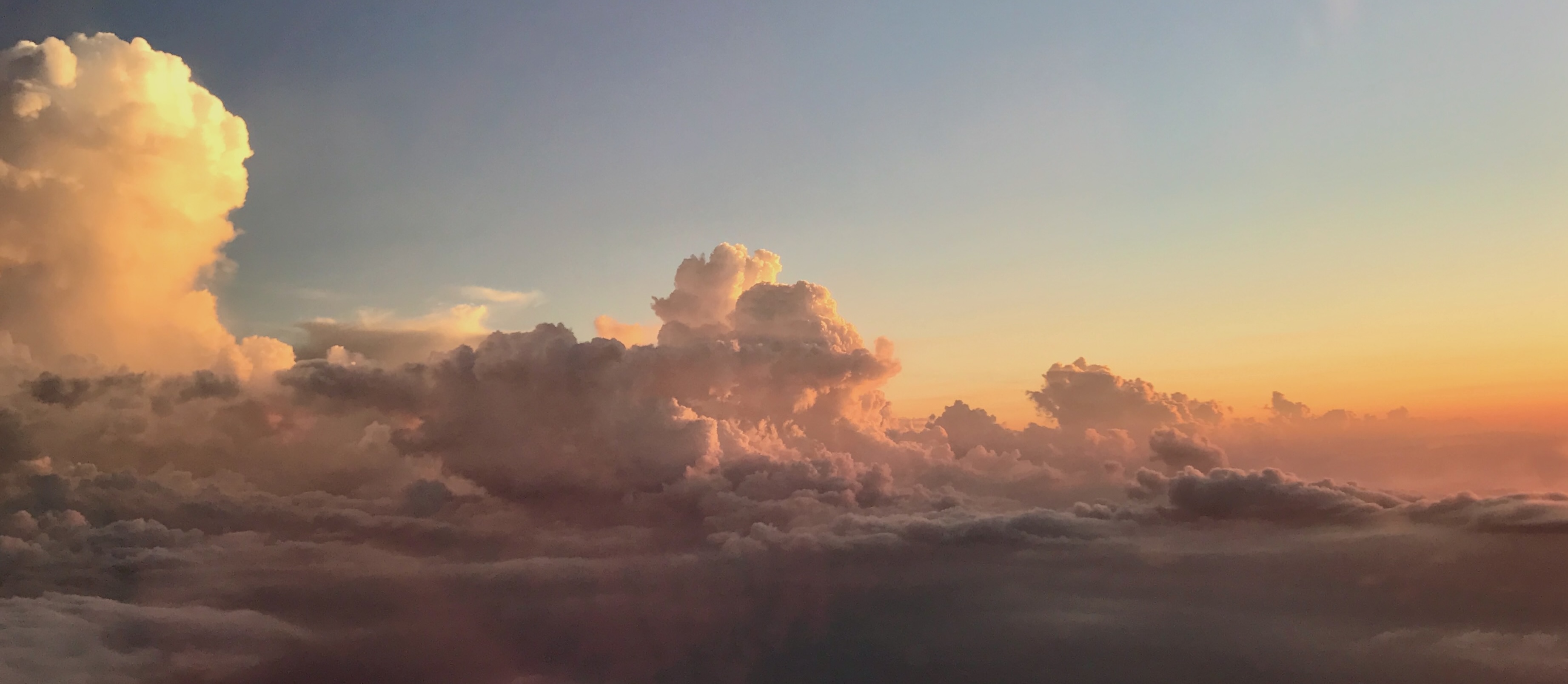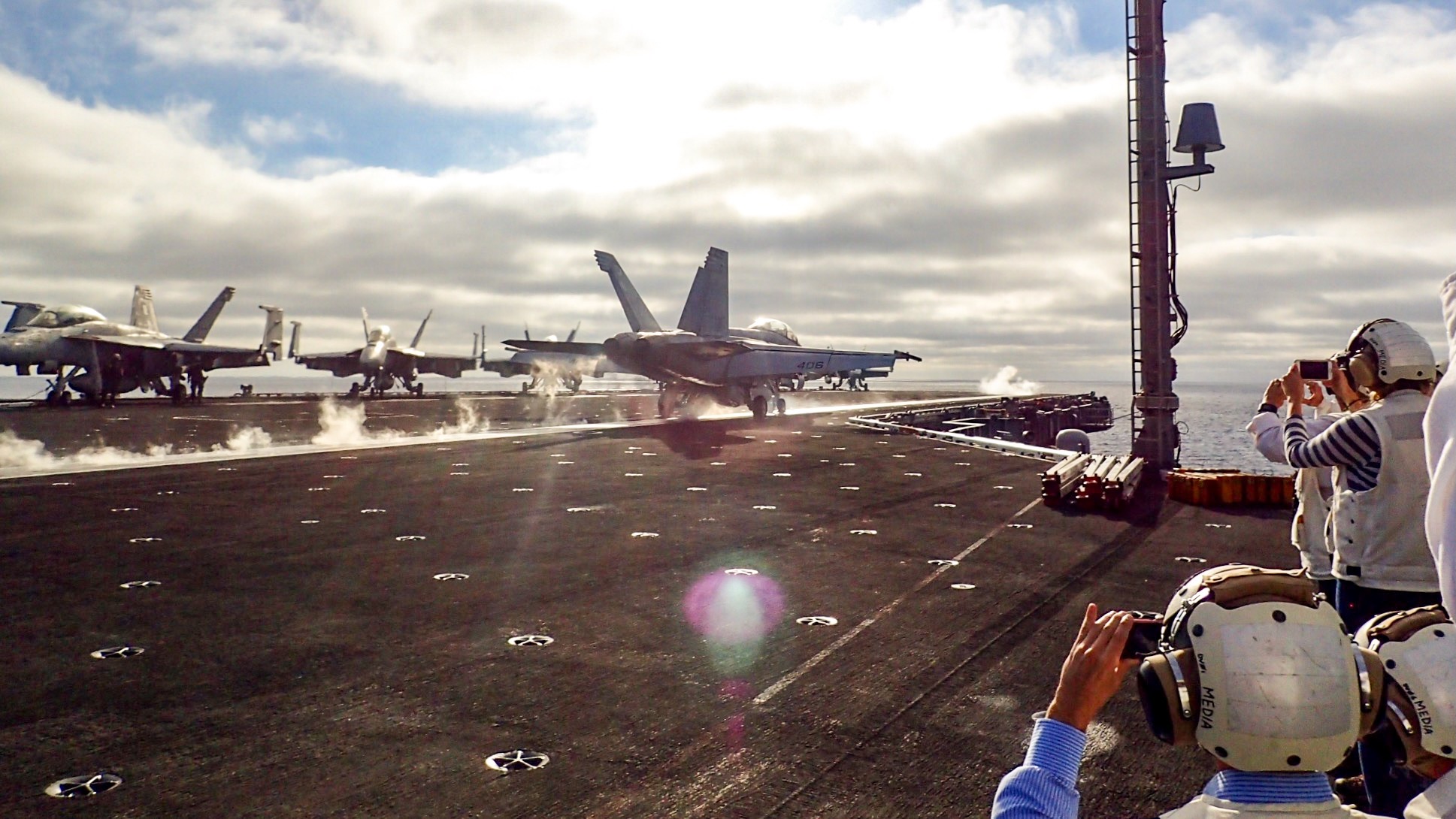People
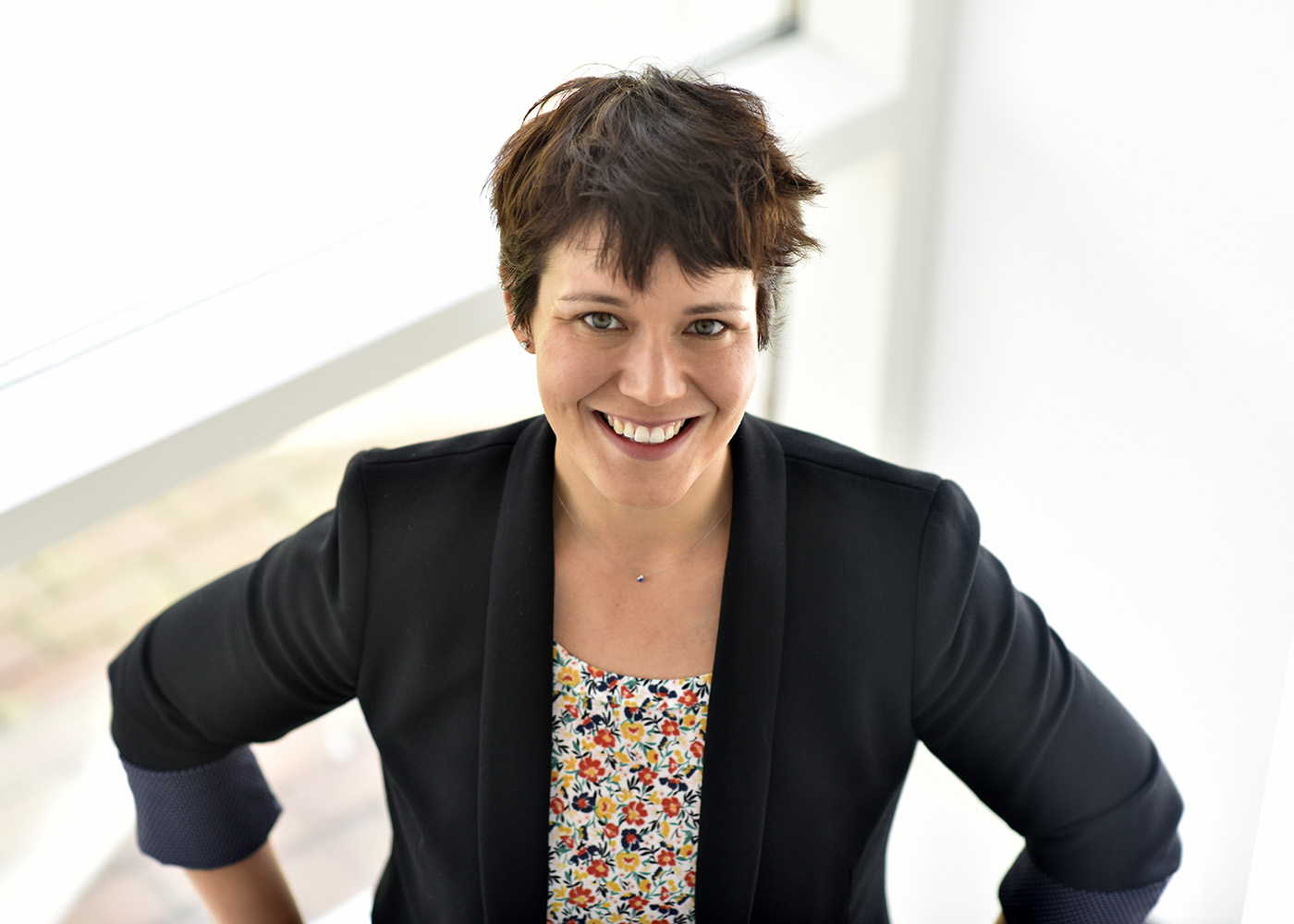
Prof. Anya Jones [GS, CV]
Originally from New Orleans, LA, Prof. Jones joined the UCLA Department of Mechanical and Aerospace Engineering in 2024 after 14 years on the Aerospace Engineering faculty at the University of Maryland (UMD). She earned her Ph.D. in experimental aerodynamics from the University of Cambridge, her S.M. from MIT in Aeronautics and Astronautics, and a dual B.S. from Rensselaer Polytechnic Institute in Aeronautical and Mechanical Engineering. In addition to running her lab, she teaches graduate and undergraduate courses in unsteady aerodynamics, incompressible aerodynamics, and fluid mechanics. Prof. Jones has been awarded the AFOSR Young Investigator Award, NSF CAREER Award, and the Presidential Early Career Award for Scientists and Engineers (PECASE). She has been a Fulbright Scholar at the Technion in Haifa, Israel, an Alexander von Humboldt Fellow at TU Braunschweig in Germany, a Visiting Professor at Tohoku University in Japan, and a Visiting Scientist at Istanbul Technical University in Turkey. She is a fellow of the American Physical Society, Division of Fluid Dynamics (APS DFD), an associate fellow of AIAA, and a long-time chair and participant in several NATO Science and Technology Organization task groups on unsteady aerodynamics.
Graduate Students
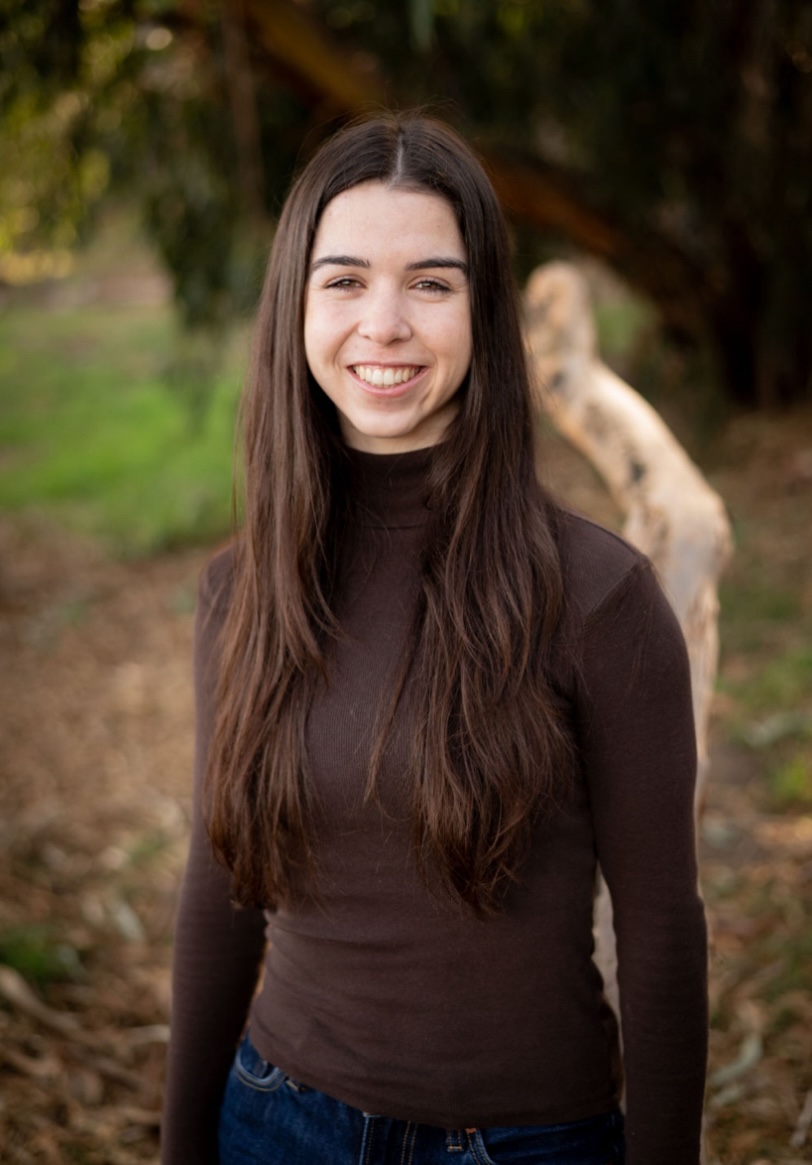
Mackenzie Ficke
Mackenzie was born in Long Beach, CA. She earned her B.S. in aerospace engineering at UCLA, and is currently working towards her M.S. in the same field with an emphasis on fluid dynamics. Outside of the lab, she works as a fastpitch softball pitching instructor. In her free time she enjoys surfing, crochet, and hiking!.

Henry Jones
Henry was born and raised outside of Austin, Texas. He had an early passion for all types of aircraft and the theory of flight. Eager to learn more, Henry studied Aerospace Engineering at UCLA with a focus in aeronautics. He will received his Bachelor's degree in the Spring of 2025 and is currently pursuing his Master's degree. To further his understanding of aerodynamics and contribute to the field of research, Henry joined the lab during his senior year of undergrad. In his free time, Henry enjoys hiking, road tripping, and rewatching the Lord of the Rings too often.
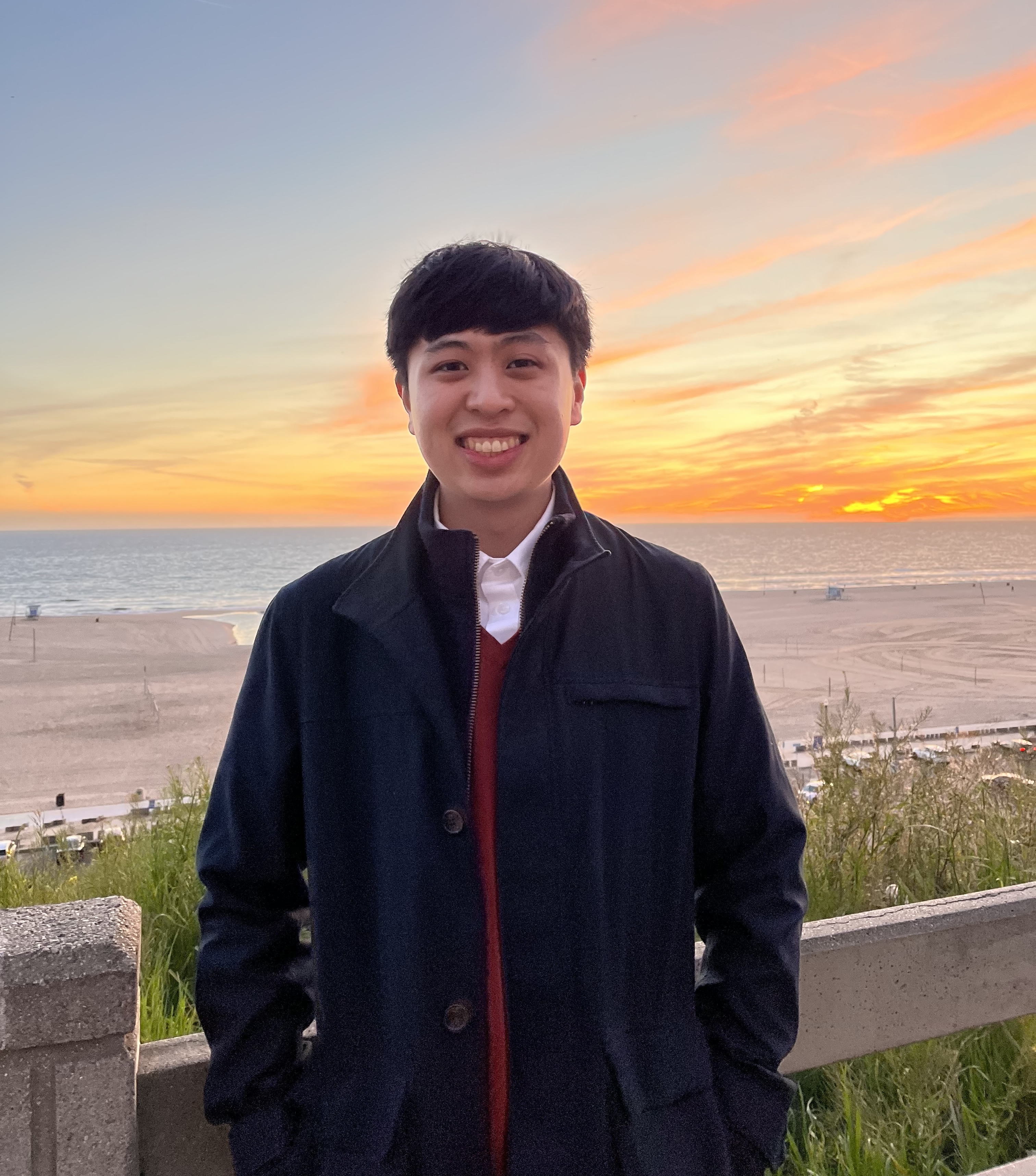
Kevin Nguyen
Kevin was born and raised in San Jose, CA. He received his B.S. in Mechanical Engineering from UCLA in 2024 and is now pursuing an M.S. in Mechanical Engineering. Kevin joined the lab to gain hands-on research experience, which he hopes to apply to research and development in industry. His current work focuses on investigating the 2D-to-3D transition of the leading edge vortex. In his free time, he enjoys running, hiking, and writing film reviews. He also can often be found birdwatching at the Bolsa Chica Ecological Reserve or Griffith Park.
Undergraduate Students
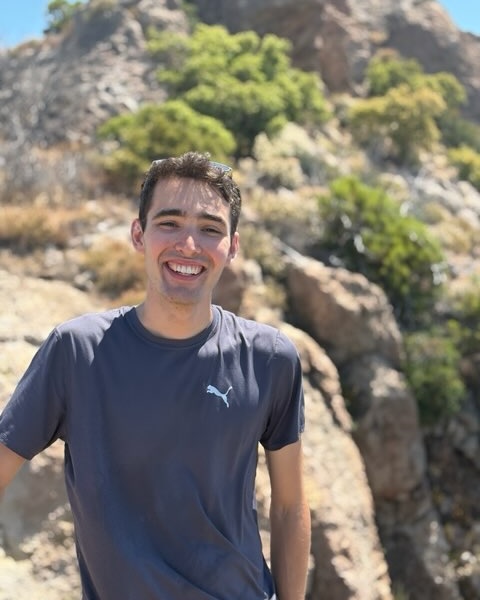
Chris Orr
Chris grew up in Oxford, UK before coming to Los Angeles for undergrad at UCLA. Chris joined the lab to broaden his understanding of aerodynamics to include hands-on testing and to help contribute to the lab's research. He will receive his Bachelor's in Mechanical Engineering in Spring 2026 and plans to pursue post-graduate studies with a focus on aerodynamics, both computational and experimental. Outside of academic work, Chris is a lifelong Formula One fan, which first sparked his interest in aerodynamics and fluid mechanics. He can also often be found running the Santa Monica beach path training for his next marathon.
Alumni (UCLA)
MS
Zach Cowger completed his M.S. in the summer of 2025 and accepted a job as a mechanical engineer at nLIGHT in Camas, WA.
Alumni (UMD)
PhD
Antonios Gementzopoulos completed his Ph.D. at the end of 2024 and began a postdoc in the High-Speed Aerodynamics and Propulsion Laboratory at the University of Maryland.
Oliver Wild completed his Ph.D. at the end of 2024 and began working as an Aerodynamics Engineer at Lucid Motors in Newark, CA.
Girguis Sedky completed his Ph.D. in December of 2022 and began work as Postdoctoral Research Associate at Princeton University in January 2023.
Hülya Biler completed her Ph.D. in December of 2021 and moved to the University of Southampton in the UK to begin work as a Research Fellow in the Aeronautics and Astronautics.
Jonathan Lefebvre completed his Ph.D. in May of 2021 and began working as a Research Analyst in Future Vertical Lift at The Institute for Defense Analyses (IDA) in Alexandria, VA.
Luke Smith completed his Ph.D. in May of 2020 and accepted a position as an engineer in the Hydroacoustics and Propulsor Design branch of the Carderock Division of the Naval Surface Warfare Center in Maryland.
Field Manar completed his Ph.D. in January of 2018 and accepted a position as an engineer in the Hydroacoustics and Propulsor Design branch of the Carderock Division of the Naval Surface Warfare Center in Maryland.
Peter Mancini completed his Ph.D. in the fall of 2017 and began working as a Research Analyst in Cyber Systems at The Institute for Defense Analyses (IDA) in Alexandria, VA.
Gino Perrotta completed his Ph.D. in the fall of 2017 and moved to a postdoc position at The George Washington University in Washington, DC.
Andrew Lind completed his Ph.D. in 2015 and remained in the group as postdoc until 2017, when he began working as an Assistant Research Engineer at the Glenn L. Martin Wind Tunnel.
MS
Assaf Krupnik completed his M.S. in the spring of 2023 and began work as Flight Test Engineer at Boeing Commercial Airplanes in Seattle.
Alex Goldberg completed his M.S. in the spring of 2023 and began work as an aerodynamicist for Kaman Air Vehicles.
Zachary Smith completed his M.S. in May of 2018 and accepted a position as an engineer in helicopter dynamics at the Naval Air Systems Command (NAVAIR) in Patuxent River, Maryland.
Phil Kirk completed his M.S. in May of 2018 and accepted a position as a flight test engineer at the Naval Air Systems Command (NAVAIR) in Patuxent River, Maryland.
Nate Beals graduated in the spring of 2014 with his M.S. in Aerospace Engineering, “The Effect of Passive Deformation on the Lift Produced by a Rotating Hinged Wing” and accepted a job at the U.S. Army Research Laboratory in Aberdeen, MD.
Kristy Schlueter completed her M.S. in Aerospace Engineering from UMD in 2013, entitled “Analysis of Factors Affecting the Aerodynamics of Low Reynolds Number Rotating Wings.” She was awarded the NDSEG Fellowship in 2013 and moved on to pursue a Ph.D. at Caltech.
BS
Tak (Andy) Yeung completed his B.S. in the spring of 2024 and began his graduate studies at the University of Maryland.
Adina Fleisher completed her B.S. in the spring of 2023 and began her graduate studies at Princeton University.
Adina Fleisher completed his B.S. in the spring of 2023 and began his graduate studies at Lehigh University.
Nicholas Zhu graduated in the spring of 2019 with his B.S. in Aerospace Engineering and moved to Daytona Beach, FL to begin graduate school at Embry-Riddle.
Mohamed Nassif graduated in the spring of 2018 with his B.S. in Aerospace Engineering and moved to Atlanta, GA to begin graduate school at Georgia Tech.
Max Cassell graduated in the spring of 2016 with his B.S. in Aerospace Engineering and accepted a job at Toyon Research Corporation in Sterling, VA.
Ignacio Andreu graduated in the spring of 2016 with his B.S. in Aerospace Engineering and moved to Illinois continue his studies at the University of Illinois.
Hannah Spooner graduated in the spring of 2015 with her B.S. in Aerospace Engineering and moved to Wichita, KS to work on airframe design for Cessna.
Ryan Joyce graduated in the spring of 2015 with his B.S. in Aerospace Engineering and remained on campus to begin graduate school in the fall.
Mateusz Gabryszuk graduated in the spring of 2015 with his B.S. in Aerospace Engineering and remained in the department to begin graduate school in the fall.
Krista Cratty graduated in the spring of 2015 with her B.S. in Aerospace Engineering and moved to College Station, TX to begin graduate school at Texas A&M in the Department of Aerospace Engineering.
Michael Madden graduated in the spring of 2014 with his B.S. in Aerospace Engineering from UMD. His departmental honors thesis was entitled “Interactions between a Model Turbine and the Seafloor.” He has since moved on to work at NAVAIR in Pax River, MD, performing flight tests on the F35 Joint Strike Fighter.
Sarvesh Sethi graduated with his B.S. in Aerospace Engineering from UMD in the spring of 2014 and moved to Ann Arbor, MI to work for Vayu, a small company that designs and builds UAVs for healthcare supply chain management and post-disaster aid delivery.
Mark Glucksman-Glaser earned his B.S. in Aerospace Engineering from UMD in 2010 and M.S. in 2013, entitled “Effects of Model Scaling on Sediment Transport in Brownout.” He moved on to work for ISSI, supporting NAVAIR at Pax River, MD.
Sid Kolluru completed his B.S. in Aerospace Engineering in 2010 from UMD and his M.S., entitled “Unsteady Low Reynolds Number Aerodynamics of a Rotating Wing,” in 2012. He moved on to work in experimental aerodynamics for Bell Helicopter in Ft. Worth, TX.
Baozhu Zhang was an undergraduate research assistant and a Women in Engineering Research Fellow in 2011-2012. She completed her M.S. in systems engineering at UMD in the spring of 2014, and then moved on to work at AAI as a systems engineer in Cockeysbille, MD.
Oscar Alvarado, an undergraduate research assistant in 2011, completed his M.S. in the AeroSmart lab in 2013.
Research
Complex gust encounters
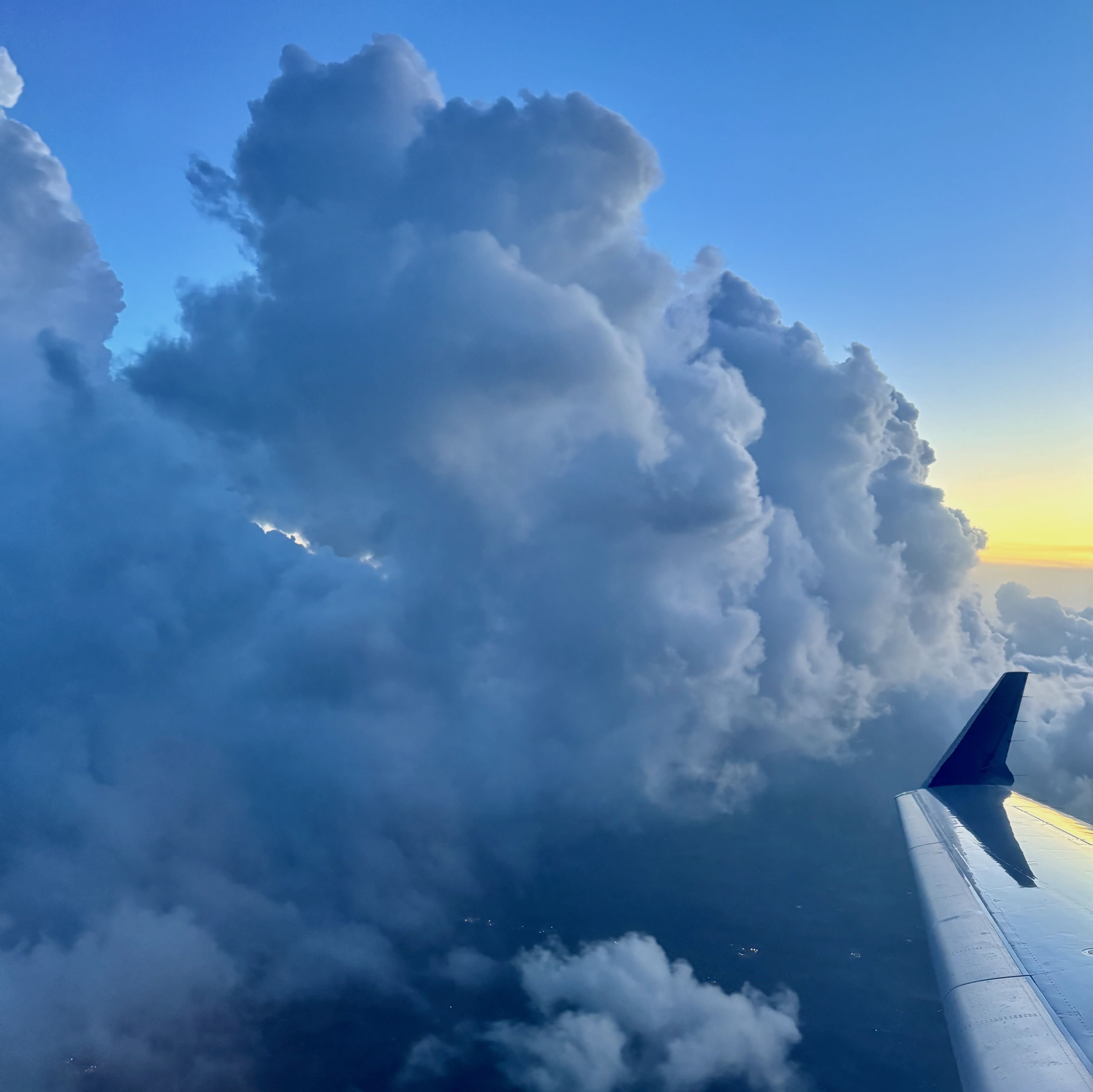
The flow disturbances and wind gusts that aircraft experience in flight are complex mixtures of many different types of flows. Traditionally, however, wind gusts are modeled as either continuous or discrete. Continuous gusts include things like atmospheric turbulence, while discrete gusts are larger scale coherent flow structures like vortices or updrafts. STAL has previously focused on extreme discrete transverse gust encounters, but we are currently looking to expand that work into the area of complex gusts where we will consider the effects of multiple types and scales of discrete and continuous gusts interacting with a wing simultaneously. Current efforts are focused on learning how to generate these types of gusts in a water channel, how to quantify and characterize these flows, and how a wing's response to these types of gusts differs from that of a two-dimensional discrete gust.
Baseball aerodynamics
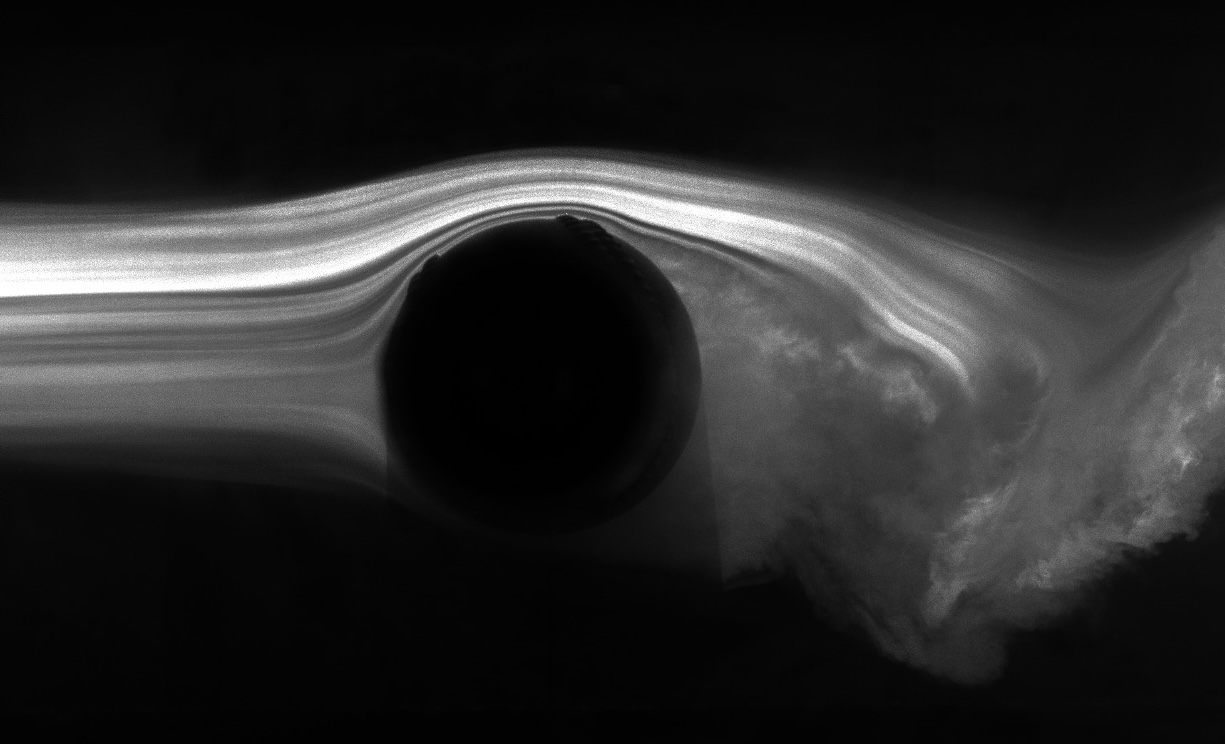
Pitched baseballs experience aerodynamic forcing from a number of sources including flow separation on the downstream side of the ball and the Magnus effect due to the spin imparted by the pitcher. Previous work has suggested that the sewn seams on a baseball can act to trip the boundary layer, incite flow separation, or possibly trigger laminar separation bubbles, giving rise to a "seam-shifted wake." Each of these mechanisms has a different effect on the aerodynamic forcing and wake of the ball, suggesting that the orientation of the seams could, in some cases, significantly affect ball trajectory. We are currently working with a major league baseball team to visualize and quantify the effect of seam positioning and rotational axis on the flow separation and lift generation of a spinning baseball in a wind tunnel.
Extreme transverse gust encounters
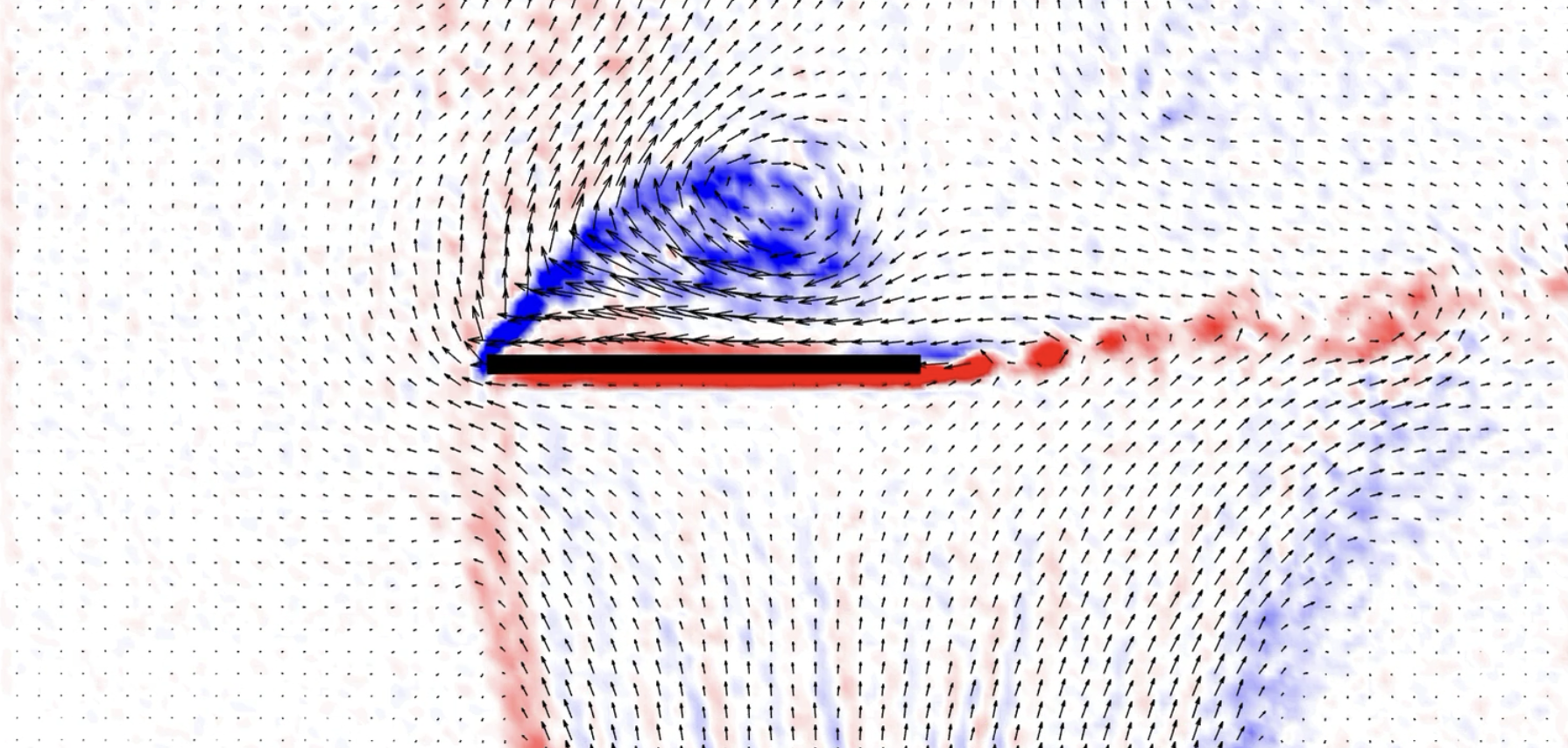
Wings hit by very strong flow disturbances tend to experience large transients in lift, drag, and pitching moment. If the flow disturbance or wind gust is of the same order of magnitude as the flight speed of the vehicle, unsteady flow separation is likely to occur, resulting in the formation of a leading-edge vortex. We study the process of flow separation, vortex formation, shedding, and convection to better understand how unsteady forces are generated, how we can predict when flow separation occurs, and how we can reduce force transients for better aircraft performance in unsteady conditions.
Swept wing gust encounters
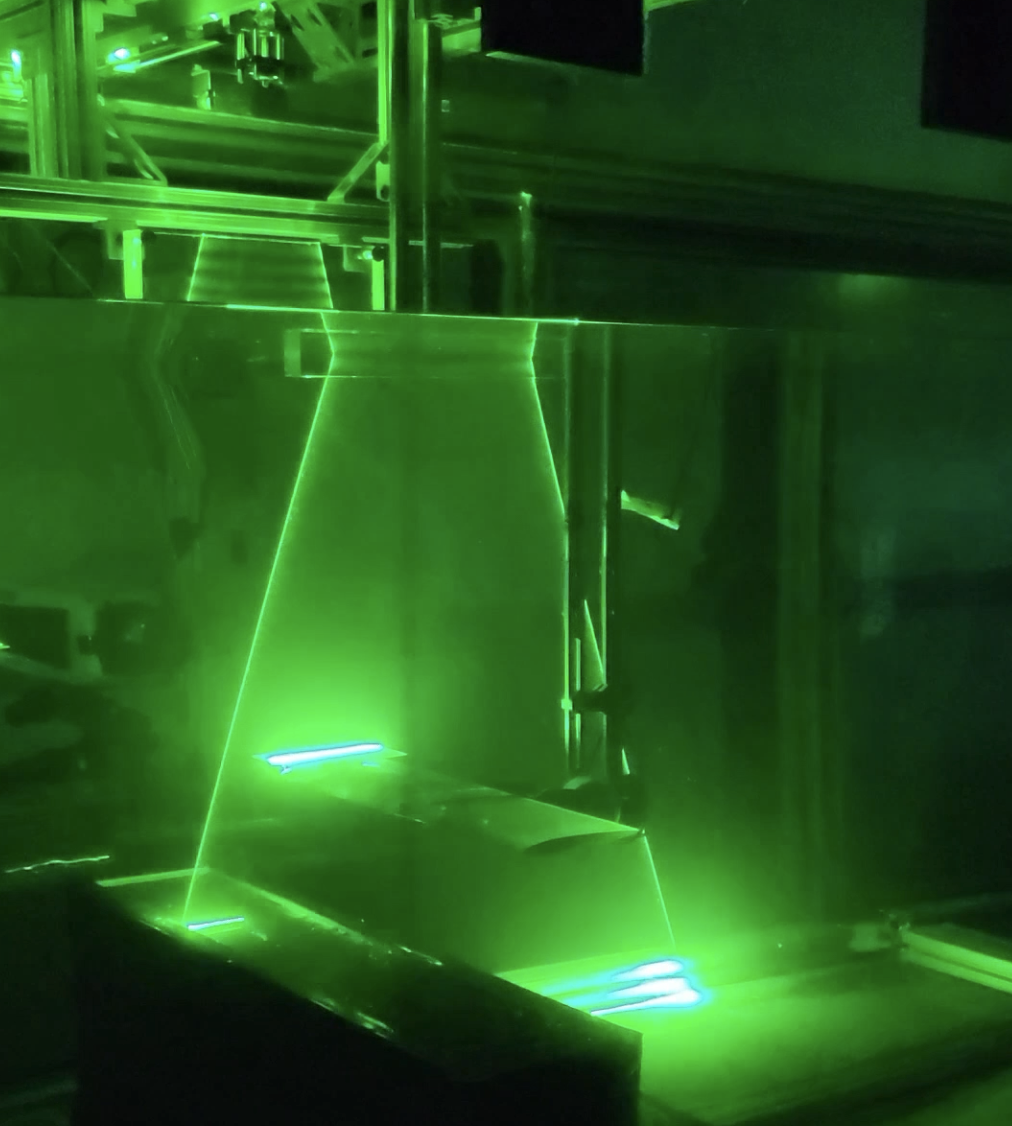
A swept wing gust encounter is an inherently three-dimensional flow because of the wing geometry and because a 2D gust will impact the wing at different points along the span at different times. We use three-dimensional Lagrangian particle tracking velocimetry to measure all three components of the velocity field over a section of the wing. Having acquired these data, it is possible to explore vorticity generation and transport and so study the development and coherence of the three-dimensional leading-edge vortex. Ongoing work aims to explore the effects of wing sweep angle on the underlying physics of flow separation and reattachment and evaluate how existing flow models might be applied to three-dimensional flows or what modifications are necessary to capture the dominant 3D effects.
Flow sensing and modeling
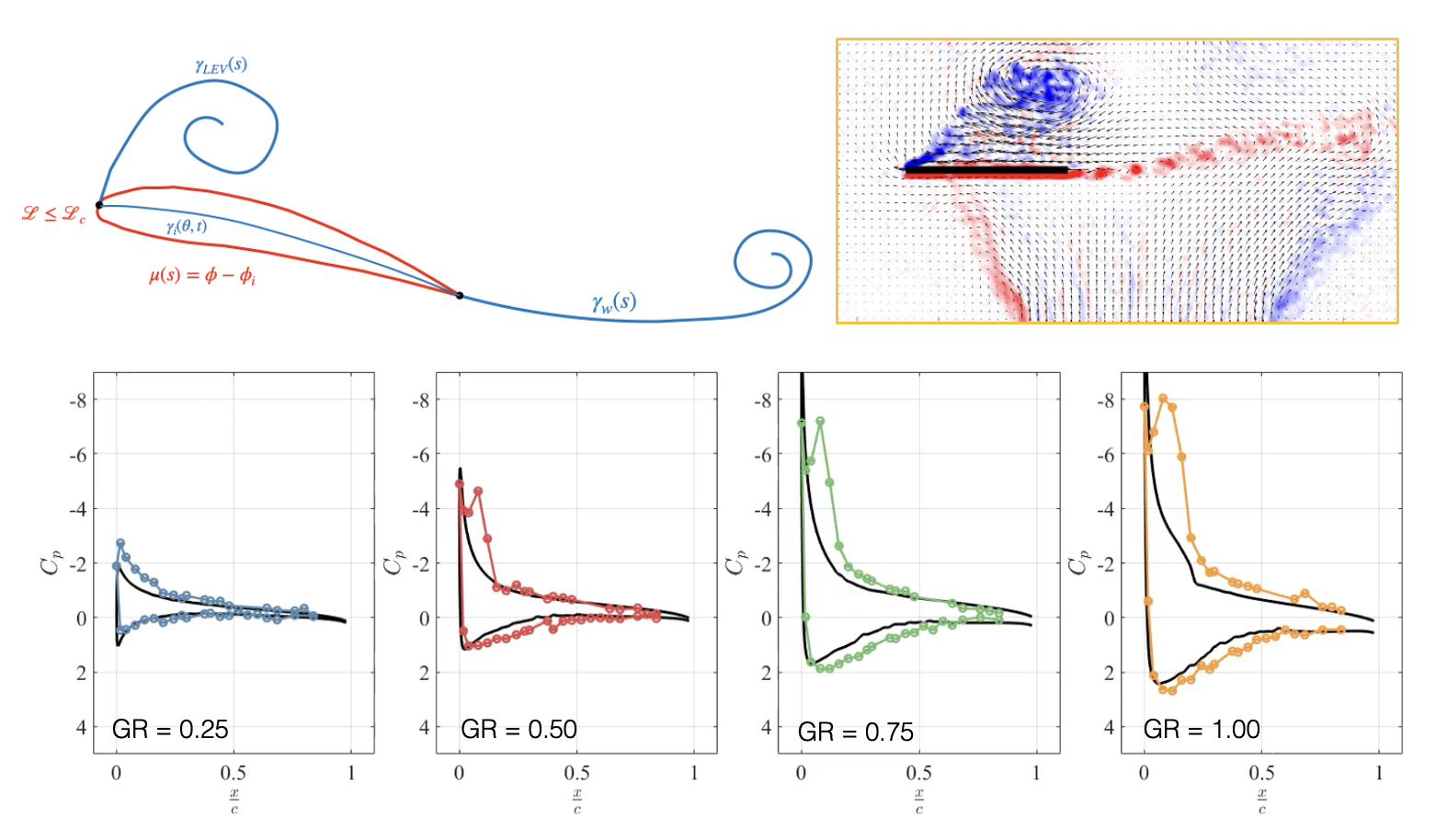
One of the biggest challenges in mitigating the effects of gust encounters lies in knowing when an impending gust will hit. To better sense and predict gust encounters we perform experiments on wings with embedded pressure sensors. Having acquired a complete set of time-resolved pressure measurements along the surface of the wing, it is possible to both compute the aerodynamic forces on the wing and to explore the relative importance of each sensor. Unsteady pressure data can then be used in combination with theoretical and data-driven models to help predict an impending gust encounter and to leverage our understanding of the underlying flow physics to improve these models.
Gust mitigation

One of the primary motivations for studying gust encounters is to find ways to reject gusts or mitigate their effects on aircraft. We explore different ways to apply flow control or enact vehicle maneuvers to reduce lift transients in extreme gust encounters. To do this, we must first understand the underlying mechanisms of force generation and what types of actuators or maneuvers might have the control authority and time response required. We then develop the necessary control laws and test these approaches in experiments and simulations.
Vortex breakdown
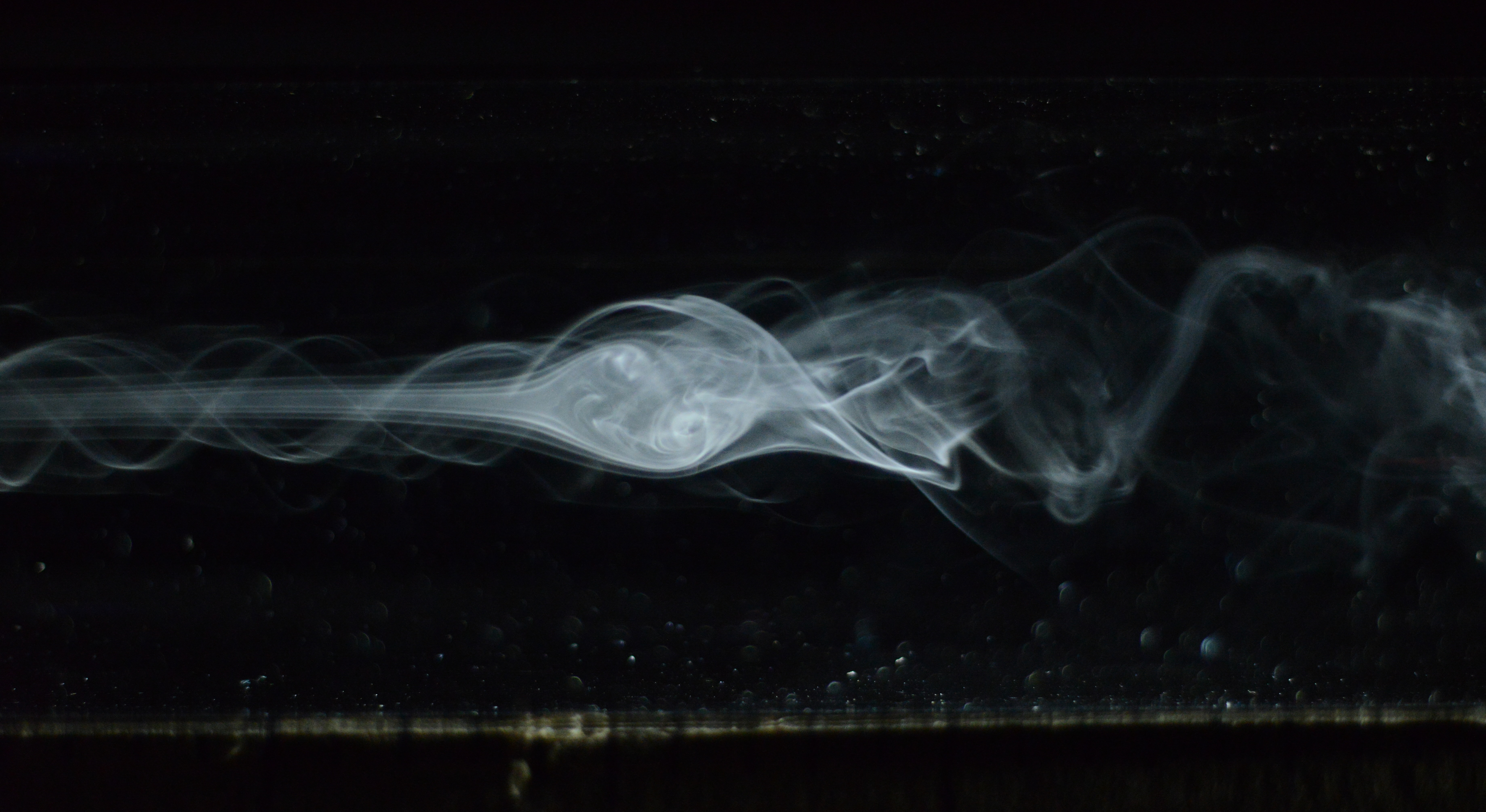
Vortex breakdown is a well-known phenomena that occurs when a vortex loses its coherent structure and "bursts" into something more chaotic. While this process has been studied for many years, new measurement techniques are making it possible quantify this process over the rapid time scales over which it occurs. Because the process is highly sensitive to flow conditions, measurement techniques must be nonintrusive but also capable of capturing fully three dimensional measurements very quickly. Recent experiments were inspired by the "blue whirl", a flame thought to be a form of vortex burst. In these experiments we studied the effect of heat addition on a non-combusting flow by measuring the three-dimensional velocity field within the core of a standing vortex.
Rotor aerodynamics

Much of our previous work on rotor aerodynamics has focused on the reverse flow region of a high advance ratio rotor, where the relative flow moves "backwards," from the conventionally sharp geometric trailing edge of the wing to the conventionally blunt geometric leading edge. When this occurs, flow tends to separate quickly, sometimes forming a strong reverse flow dynamic stall vortex that can give rise to large lift and pitching moment transients. To alleviate these transients, airfoils designed to accommodate reverse flow often have a blunt trailing edge in addition to the conventional blunt leading edge. Previous experiments have included time-resolved particle image velocimetry measurements on a Mach-scaled rotor as well as numerous smaller scale experiments in wind tunnels and towing tanks on pitching and swept blades in both forward and reverse flow.
